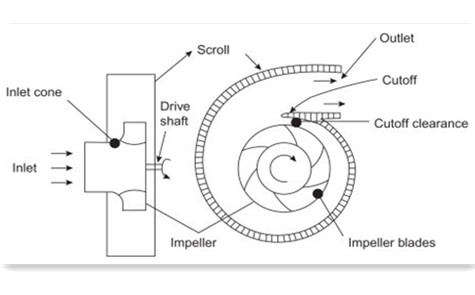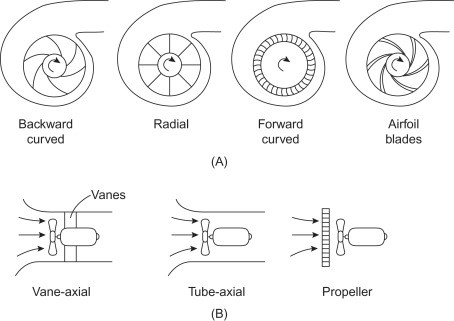Acoustic Characteristics of Centrifugal Fans
- Home>>News>>Company NewsAcoustic Characteristics of Centrifugal Fans
Acoustic Characteristics of Centrifugal Fans
The acoustic properties of a centrifugal fan are influenced as much by the aerodynamics of the impeller as by the acoustical properties of the scroll casing. Fig. 6.53 illustrates the primary components of the centrifugal fan, and Fig. 6.54 illustrates the various types of fans. Compared to the degree of study and measurement conducted on axial flow fans, centrifugal fans have received little attention. A review paper, outlines the primary noise-control measures for centrifugal fans, while design considerations have been discussed. The centrifugal fan is more complicated aeroacoustically than the axial flow fan, and the acoustic resonances in the scroll casing influence the sound spectrum.

Figure 6.53. Important parts of a centrifugal blower.

Figure 6.54. Important types of fans for industrial and domestic applications for which sound power levels are given in Fig. 6.56. (A) Common centrifugal fans and (B) common axial flow fans.
The centrifugal fan operates by the generation of a circulation in the scroll case by the rotating impeller. The air enters at the center and leaves at the outer periphery of the blading. The efficiency of the fan is affected by the annular clearance between the impeller and the scroll case and between the impeller and a point called a cutoff. The number of blades in the impeller may range from 6 to more than 60, depending on the configuration of the impeller. The simplest arrangement is a small number of radial blades, but the impeller commonly used in air-conditioning systems and in small ventilation units has a large number of smaller blades curved in the direction of rotation. The primary source of noise occurs at blade passage frequency because of the passage of impeller blades past the cutoff. Broadband noise is generated by the airflow through the impeller, on the walls of the casing, and over the ribs and stiffeners of the casing.
Experiments have been conducted to isolate the importance of acoustic resonances in the housing, and shown that small fans (fans less than 10 in. in diameter) can have a Helmholtz resonance in the frequency range of 100–1000 Hz. Large fans, such as those used in air-conditioning systems, have lower fundamental resonance frequencies, but higher-order acoustic modes of the casing volume continue to be important.
The encasement of the impeller has been identified as an important amplifier of the sound ,unenclosed impellers generate fundamentally dipole sound, although with a slightly different dependence on rotation speed than for cased impellers. Thus the fan case can alter the sound radiation, analogous to the way a half-plane alters the speed dependence of dipole sound from U6 to U5.
- Max air flow fans
- Machine cooling fan
- Bitcoin digger fan
- Telecome fan
- Stage lamp fan
- Power cooling fan
- Laser module fan
- Min air flow fans
- 3D printer fan
- Amplifier fan
- Computer fan
- Inverter fan
- Charging pile fan
- Car LED lamp fan
Contact
Black@ruiapple.com
TEL:+86 13189756968
FAX:+86 755 88852020
Shenzhen Office: 508#,Tianhe biulding, Baoan Road,Shenzhen,China Factory add: 471#, West Wenwu Road, Economic and Technological Zone, Mianyang City, Sichuan Province, China
Copyright © 2019 SHENZHEN RUIAPPLE ELECTRONICS CO.,LTD Official Record No:粤ICP备19010273号
Support:RUIAPPLE










